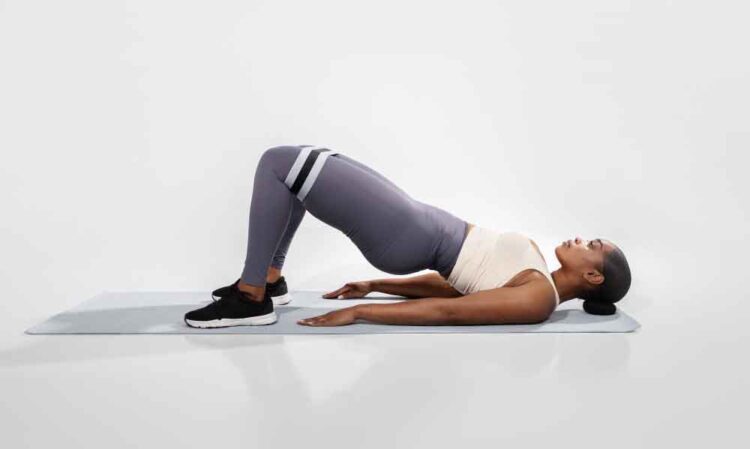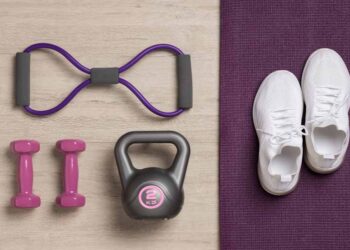Do you dream of having firmer glutes? Wondering what exercises can help you achieve your booty goals? Look no further! In this article, we’ll dive into the fascinating world of glute training and explore the secrets behind unlocking those glute bridge gains.
Glute bridges, along with other posterior chain exercises like hip thrusts, are highly effective for glute activation and strengthening. But what makes them so special? How do they contribute to firmer, more defined glutes? Let’s find out!
Key Takeaways:
- Glute bridges and other posterior chain exercises play a crucial role in glute activation and strengthening.
- Understanding the science behind glute training can help you achieve your desired glute gains.
- Consistency, proper nutrition, and targeted exercises are key in unlocking the secrets to firmer glutes.
- Building stronger glutes can have a positive impact on your overall fitness and self-confidence.
- Stay tuned to discover the secrets behind glute bridge gains and start your journey towards firmer glutes!
How Muscles Grow?
Muscles grow through a process called hypertrophy, which involves increasing muscle fiber size and count. When it comes to achieving glute gains, understanding the principles of muscle growth is essential.
One key concept in muscle growth is progressive overload. This means gradually increasing the resistance or intensity of your workouts to stimulate muscle growth. For the glutes, this could include adding weight to exercises like squats, lunges, and hip thrusts.
But it’s not just about lifting heavy weights. Nutrition also plays a crucial role in supporting muscle repair and growth. Adequate protein intake is especially important, as it provides the building blocks for muscle tissue.
Equally important is giving your muscles time to rest and recover. Muscle growth actually happens during this phase, so adequate rest and recovery is essential for maximizing glute gains.
Gender and genetics can also influence the rate and extent of muscle growth in the gluteal region. Hormonal factors, such as estrogen and testosterone, can affect fat distribution and how the glutes appear.
To specifically target glute development, it’s important to include targeted glute training exercises in your routine. In addition to compound exercises like squats and lunges, incorporating isolation exercises like hip thrusts and glute bridges can help activate and strengthen the glute muscles.
Consistency and patience are key when it comes to achieving noticeable booty gains. Building muscle takes time, so it’s important to stay consistent with your workouts and nutrition plan, and be patient with the process. Rome wasn’t built in a day, and neither were strong, firm glutes!
The Role of Nutrition in Glute Gains
A proper nutrition plan is crucial for fueling your glute muscles and supporting their growth. To achieve booty gains, focus on consuming a well-balanced diet that includes an adequate amount of protein, carbohydrates, and healthy fats.
Protein is particularly important for muscle repair and growth. Aim to consume sources of high-quality protein, such as lean meats, eggs, dairy products, legumes, and plant-based protein sources like tofu and tempeh.
Carbohydrates provide the energy necessary for intense workouts and overall muscle function. Incorporate complex carbohydrates from whole grains, fruits, and vegetables into your diet.
Don’t forget about healthy fats! Including sources of monounsaturated and polyunsaturated fats, like avocados, nuts, seeds, and fatty fish, can provide essential nutrients and support overall health.
Hydration is also key for muscle function and nutrient transport. Make sure to drink enough water throughout the day to stay properly hydrated.
Lastly, don’t underestimate the power of rest and recovery. Your glute muscles need time to repair and grow, so prioritize sleep and give yourself regular rest days to optimize your booty gains.
Gender and Genetic Influences on Glute Growth
While everyone can achieve glute gains with targeted training and proper nutrition, it’s important to note that gender and genetics can play a role in the rate and extent of muscle growth, including in the gluteal region.
Typically, males tend to have a higher potential for muscle growth due to higher levels of testosterone. However, females can still achieve significant glute gains through consistent training and nutrition.
Genetics also play a role in determining muscle shape and size, including the appearance of the glutes. Some individuals may naturally have a predisposition for a certain glute shape or size, but targeted training can still help enhance and strengthen the glutes.
It’s important not to compare yourself to others, as we all have unique genetic factors that influence our muscle growth potential. Instead, focus on your own progress and celebrate the improvements you make on your personal glute journey.
| Factors influencing glute gains | Key takeaways |
|---|---|
| Progressive overload | Gradually increase resistance or intensity to stimulate muscle growth |
| Nutrition | Adequate protein intake is crucial for muscle repair and growth |
| Rest and recovery | Muscle growth occurs during this phase, prioritize rest for optimal gains |
| Gender and genetics | Can influence the rate and extent of muscle growth in the gluteal region |
| Hormonal factors | Estrogen and testosterone can affect fat distribution and glute appearance |
| Targeted glute training | Focus on exercises that activate and strengthen the glutes |
| Consistency and patience | Stay consistent with workouts and nutrition, and be patient with the process |
Fueling Your Glute Muscles
Nutrition plays a pivotal role in fueling your glute muscles and achieving booty gains. A balanced diet rich in protein, carbohydrates, and healthy fats supports muscle growth and provides energy for workouts. Including lean sources of protein, such as chicken breast, fish, and tofu, helps repair and build glute muscles. Complex carbohydrates, like whole grains and sweet potatoes, provide sustained energy for intense glute-building exercises.
When it comes to fats, opt for sources like avocados, nuts, and olive oil. These healthy fats support hormone production and aid in nutrient absorption. Hydration is also crucial for maintaining muscle function and overall health. Aim to drink at least 8 glasses of water a day to ensure optimal hydration.
Recovery: The Secret Ingredient
While glute-building exercises are important, adequate recovery is equally essential. Your glute muscles need time to repair and grow stronger after intense workouts. Recovery includes both rest and sleep, which play instrumental roles in muscle recovery and growth.
Allowing yourself sufficient rest between workout sessions gives your glute muscles the opportunity to heal and regenerate. Aim for at least 1-2 days of rest per week. Additionally, prioritize quality sleep, as it promotes optimal hormone function and muscle recovery. Aim for 7-9 hours of sleep per night to maximize your glute gains.
Remember, your glute muscles don’t grow in the gym. They grow while you rest and recover.
Achieve Optimal Nutrition and Recovery
To enhance the results of your glute-building efforts, it’s important to prioritize both nutrition and recovery. Consider incorporating the following strategies:
- Plan and prepare your meals in advance to ensure a balanced and nutritious diet.
- Include a variety of glute-building exercises in your workout routine to target different muscle fibers and enhance overall development.
- Implement progressive overload, gradually increasing the weight or intensity of your exercises over time.
- Take rest days to allow your glute muscles to recover and avoid overtraining.
- Establish a consistent sleep schedule to promote optimal muscle recovery and growth.
| Nutrition Tips | Recovery Strategies |
|---|---|
| Consume lean protein sources: chicken breast, fish, tofu | Get at least 7-9 hours of quality sleep per night |
| Incorporate complex carbohydrates: whole grains, sweet potatoes | Take 1-2 rest days per week to allow for muscle repair |
| Include healthy fats: avocados, nuts, olive oil | Avoid excessive cardio and prioritize active recovery |
| Stay hydrated: drink at least 8 glasses of water per day | Engage in stress-relieving activities such as yoga or meditation |
By fueling your glute muscles with proper nutrition, staying hydrated, and prioritizing recovery through rest and sleep, you are setting the stage for optimal growth and achieving your desired booty gains.
Crafting Your Glute-Building Workout Routine
Designing a glute-building workout routine involves incorporating both compound and isolation exercises. Compound exercises, such as squats, deadlifts, and lunges, engage multiple muscle groups, including the glutes. Isolation exercises, like hip thrusts and glute bridges, specifically target the glutes.
Starting with a dynamic warm-up is crucial to prepare your muscles and joints for the workout. This can include exercises like jogging in place, jumping jacks, or dynamic stretches that focus on the lower body. The warm-up increases blood flow, raises your body temperature, and helps prevent injury during the workout.
Incorporating compound exercises into your routine is essential for overall strength and muscle development. These exercises recruit multiple muscle groups simultaneously, including the glutes, making them highly effective. Aim to perform compound exercises with challenging weights and low repetitions to stimulate muscle growth and strength gains.
Isolation exercises should also be included to specifically target the glute muscles. Hip thrusts and glute bridges are popular isolation exercises that activate and strengthen the glutes. Incorporate higher repetitions into your isolation exercises to target endurance and muscle definition.
Finally, it’s crucial to end your workout with a proper cool-down. A cool-down helps your body return to a resting state and reduces muscle soreness. Include static stretching exercises that focus on the major muscle groups worked during the workout, including the glutes. This will improve flexibility, enhance recovery, and prevent post-workout muscle tightness.
Sample Glute-Building Workout Routine:
- Dynamic Warm-up:
- Jumping jacks – 2 sets of 20 repetitions
- High knees – 2 sets of 20 repetitions
- Walking lunges – 2 sets of 10 repetitions per leg
- Leg swings – 2 sets of 10 repetitions per leg
- Compound Exercises:
| Exercise | Sets | Repetitions |
|---|---|---|
| Squats | 3-4 | 8-10 |
| Deadlifts | 3-4 | 8-10 |
| Lunges | 3-4 | 8-10 per leg |
- Isolation Exercises:
| Exercise | Sets | Repetitions |
|---|---|---|
| Hip Thrusts | 3-4 | 12-15 |
| Glute Bridges | 3-4 | 12-15 |
- Cool-down:
- Quadricep stretch – 2 sets of 30 seconds per leg
- Hamstring stretch – 2 sets of 30 seconds per leg
- Glute stretch – 2 sets of 30 seconds per leg
- Lower back stretch – 2 sets of 30 seconds
A well-rounded glute-building workout routine includes a combination of compound exercises, isolation exercises, and a warm-up and cool-down. By incorporating these elements into your routine, you can effectively target and strengthen your glute muscles, promoting overall muscle development and helping you achieve the booty gains you desire.
Conclusion
Building bigger glutes requires dedication, patience, and knowledge. By incorporating glute exercises into your workout routine with proper form, progressive overload, and a balanced nutrition plan, you can achieve your dream booty. Glute gains are not just about aesthetics; they contribute to overall strength, confidence, and well-being.
Following a well-designed workout routine that emphasizes proper nutrition and recovery, and maintaining consistency and dedication, is key to unlocking the secrets to firmer glutes. The journey to stronger glutes is not an overnight process, but with persistence, you can enjoy the benefits of a more confident and resilient you.
Remember, it’s time to stop dreaming and start taking action toward your glute goals. With determination and a strategic approach, you can sculpt your glutes and build the strength and confidence you desire.














